The Real Power of Arts Integration
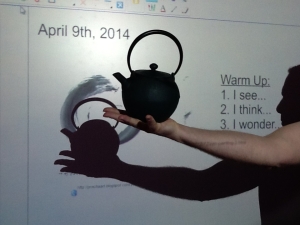 Guest Blog by Rob Levit, Founding Director, Creating Communities, Member of Maryland Nonprofits
Guest Blog by Rob Levit, Founding Director, Creating Communities, Member of Maryland Nonprofits
Join Rob October 16th for a special program: How Integrating an Arts Program into Your Nonprofit Organization Can Increase Client Outcomes, Public Visibility, and Funding.
Read the original blog here.
In her profound book Emotional Sobriety, Dr. Tian Dayton shares research on how learning is “double coded” for children – cognitively and emotionally. In addition, there is a section dedicated to the “emotional body” and how learning and life experiences are deeply embedded not only in the mind but in the body. Even though the book was originally written to understand how to recover and become resilient from emotional trauma, it has deep implications for how we educate children and the power of arts integration. The real power of arts integration is that it fully capitalizes on “double coded” learning by intertwining fact gathering, hypothesizing and synthesizing with hands-on, active and emotional learning. In a virtuous cycle, knowledge is deeply embedded through personal experience and creativity and creativity brings learning to life and breathes significance into what otherwise remain only fact-based (aka boring) assignments. In arts integration, the learner is no longer removed from the subject, they are fully engaged with it. The first week of April, I was Artist-in-Residence at Annapolis Middle School working with two excellent 7th grade social studies teachers, Ms. Cooper and Ms. Millstein. The students were immersed in their South Asia unit. The objective was to “teach for understanding” so that students knew the differences between Hinduism, Islam and Buddhism and how these differences may lead to conflict. As a team, we decided to create three simple pieces of art to represent each religion. That way the students would not only fulfill the traditional learning objectives of compare/contrast but they would also, experience, with their own hands, what the creative act may feel like from a particular cultural perspective. The students would receive both cognitive learning (fact gathering, hypothesizing and reasoning about the three religions and cultures) and emotional learning (creating with their hands, designing, wondering, imagining and pride of ownership in their work).
Project Steps:
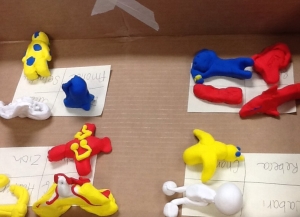 1. Show colorful and evocative examples of art from each culture/religion. Using the See/Think/Wonder thinking routine, allow students to gather facts (See – Cognitive), hypothesize on what they see (Think – Cognitive) and use their imaginations and connections to go deeper into the art (Wonder – Emotional and Cognitive fusion).
1. Show colorful and evocative examples of art from each culture/religion. Using the See/Think/Wonder thinking routine, allow students to gather facts (See – Cognitive), hypothesize on what they see (Think – Cognitive) and use their imaginations and connections to go deeper into the art (Wonder – Emotional and Cognitive fusion).
2. Select simple materials to create art based on the examples shown. In our project, we decided to create one piece of art per day.
Day 1 – Hindu art: Make statues from Model Magic that described our best personal qualities. Embody these qualities in animals or objects. We made it very clear to the students not to make gods but we wanted them to understand how polytheism developed based on basic human needs and expressions like gratitude, fear and love. By creating sculptures from a very simple and readily available material, students could focus on bringing their ideas to life rather than getting bogged down in a hard to manipulate or messy material like clay. Both Ms. Cooper and Ms. Millstein made Ganesha (the multi-limbed elephant) and students were able to draw parallels to the teachers by saying things like “teachers have to multi-task” and “teachers reach out to us.” During class, the music of India was playing in the background.
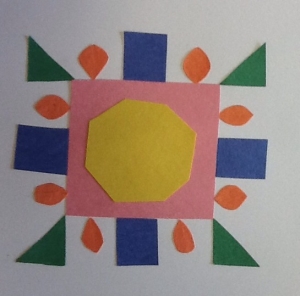 Day 2 – Islamic Art: Teachers cut up sheets of colored construction paper and students were charged with making art that reflected the complex geometric patterns in Islamic art. Several students made the connection to the fact that Islam forbids personified representations of divinity and that Islamic thinkers had a historical “golden age” where they advanced the study of mathematics. During class, the music of Turkey was playing in the background.
Day 2 – Islamic Art: Teachers cut up sheets of colored construction paper and students were charged with making art that reflected the complex geometric patterns in Islamic art. Several students made the connection to the fact that Islam forbids personified representations of divinity and that Islamic thinkers had a historical “golden age” where they advanced the study of mathematics. During class, the music of Turkey was playing in the background.
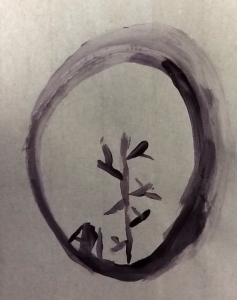 Day 3 – Buddhist Art: Students created Enso or circles and learned to value simplicity, creating with single strokes, leaving details out and noticing space. They also saw and touched an authentic Japanese teapot and set of mugs and observed their circular shape and simplicity and made the connection to the Enso. During class, the music of Japan was playing in the background.
Day 3 – Buddhist Art: Students created Enso or circles and learned to value simplicity, creating with single strokes, leaving details out and noticing space. They also saw and touched an authentic Japanese teapot and set of mugs and observed their circular shape and simplicity and made the connection to the Enso. During class, the music of Japan was playing in the background.
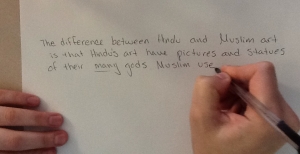 3. Allow student art to become the basis for assessed student reflection. How amazingly powerful is it for students to base their reflections on their own creations rather than something external (a picture of a piece of art shown on a screen)? Students have been given the opportunity to step into another culture and way of creating, so it makes sense that their reflections should come from this experience also. Students have the opportunity to assess their own understanding of religion and culture based on what they created rather than on what they merely viewed. Students produced Brief Constructed Responses, based on their own art, that could be assessed by the teachers as to whether the understood the fundamental tenets of each religion.
3. Allow student art to become the basis for assessed student reflection. How amazingly powerful is it for students to base their reflections on their own creations rather than something external (a picture of a piece of art shown on a screen)? Students have been given the opportunity to step into another culture and way of creating, so it makes sense that their reflections should come from this experience also. Students have the opportunity to assess their own understanding of religion and culture based on what they created rather than on what they merely viewed. Students produced Brief Constructed Responses, based on their own art, that could be assessed by the teachers as to whether the understood the fundamental tenets of each religion.
In closing, as educators, we need to continually create opportunities for our students to do and to make, right in the classroom, to tap into the emotional power of learning. Student engagement is a big deal these days and by engaging students with evocative examples and simple projects where creative success is easily attainable, students accomplish the goals of the curriculum (cognitive) and building understanding and empathy (emotional) by investing their own personal and creative energy.
Photo credit: Paul Gillespie/The Capital
![]() Join Maryland Nonprofits’ 2014 Annual Conference “Connecting for Impact!” November 5th at the Universities of Shady Grove in Rockville, MD.
Join Maryland Nonprofits’ 2014 Annual Conference “Connecting for Impact!” November 5th at the Universities of Shady Grove in Rockville, MD.
Connect with Maryland Nonprofits on Facebook, Twitter, LinkedIn, and Google+, tell us what you think and what kind of topics you would like to see more of on our blog.
![]() Find the perfect nonprofit career this summer, follow @MDNonprofitJobs
Find the perfect nonprofit career this summer, follow @MDNonprofitJobs
